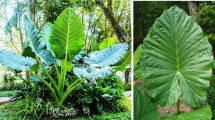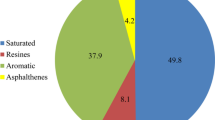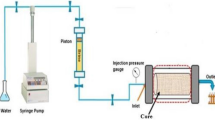Abstract
Interfacial tension (IFT) is one of the most important factors that affect oil production mechanisms in porous media. Nanoparticles show potential for high performance in IFT reduction, wettability alteration and enhanced oil recovery. The current work focuses on the simple, economical and, importantly, green method of biosynthesis to generate a nanocomposite (NC) for reducing the IFT in enhanced oil recovery. In this study, ZnO@SiO2@Xanthan NC was created from pomegranate sed extract and characterized by various analytical techniques. The nanofluids were prepared by varying the concentration of NC to find the optimum value of IFT reduction under different conditions of salinity, temperature and pressure. The results showed that by applying this nanocomposite at a concentration of 2000 ppm into a low salinity (LoSal) water at high temperature and pressure, the IFT reduced by 93.6% from 31.8 (for seawater) down to 2.016 mN/m. Further IFT reduction was obtained by the NC as the salinity of water was decreased and the temperature and concentration of NC were increased although there was no clear trend with pressure.














Similar content being viewed by others
References
Ahmadi MA, Shadizadeh SR (2017) Nano-surfactant flooding in carbonate reservoirs: a mechanistic study. Eur Phys J Plus 132(6):246
Ahmed A, Mohd Saaid I, Pilus MR, Ahmed AA, Tunio AH, Baig MK (2018) Development of surface treated nanosilica for wettability alteration and interfacial tension reduction. J Dispers Sci Technol 38:1–7
Ali JA, Kolo K, Manshad AK, Stephen K, Keshawarz A (2018) Recent advances in application of nanotechnology in chemical enhanced oil recovery: Effects of nanoparticles on wettability alteration, interfacial tension reduction, and flooding. Egypt J Pet. https://doi.org/10.1016/j.ejpe.2018.09.006
Al-Anssari S, Barifcani A, Wang S, Maxim L, Iglauer S (2016) Wettability alteration of oil-wet carbonate by silica nanofluid. J Colloid Interface Sci 461:435–442
Azarshin S, Moghadasi J, Aboosadi AZ (2017) Surface functionalization of silica nanoparticles to improve the performance of water flooding in oil wet reservoirs. Energy Explor Exploit 35(6):685–697
Basiri S (2013) Evaluation of antioxidant and antiradical properties of pomegranate (Punica granatum L.) seed and defatted seed extracts. J Food Sci Technol 52(2):1117–1123
Bayat EA, Junin R, Samsuri A, Piroozian A, Hokmabadi M (2014) Impact of metal oxide nanoparticles on enhanced oil recovery from limestone media at several temperatures. Energy Fuels 28(10):6255–6266
Bordbar M, Mortazavimanesh N (2016) Green synthesis of Pd/walnut shell nanocomposite using Equisetum arvense L. leaf extract and its application for the reduction of 4-nitrophenol and organic dyes in a very short time. Environ Sci Pollut Res 24(4):4093–4104
Dahle GS (2013) The effect of nanoparticles on oil/water interfacial tension. Project thesis, NTNU
Devi HS, Muzaffar AB, Mohammad AS, Shazia P, Abdul HW (2018) Green synthesis of iron oxide nanoparticles using Platanus orientalis leaf extract for antifungal activity. Green Process Synth. https://doi.org/10.1515/gps-2017-0145
Ebrahiminezhad A, Zare-Hoseinabadi A, Berenjian A, Ghasemi Y (2018) Green synthesis and characterization of zero-valent iron nanoparticles using stinging nettle (Urtica dioica) leaf extract. Nano Online. https://doi.org/10.1515/nano.0015.00034
El Shafey AM (2017) Effect of nanoparticles and polymer nanoparticles implementation on chemical flooding, wettability and interfacial tension for the enhanced oil recovery processes. Afr J Eng Res 5(3):35–53
Emadi S, Shadizadeh SR, Manshad AK, Rahimi AM, Mohammadi AH (2017) Effect of nano silica particles on interfacial tension (IFT) and mobility control of natural surfactant (Cedr extraction) solution in enhanced oil recovery process by nano-surfactant flooding. J Mol Liq 248:163–167
Esmaeilzadeh P, Hosseinpour N, Bahramian A, Fakhroueian Z, Arya S (2014) Effect of ZrO2 nanoparticles on the interfacial behavior of surfactant solutions at air–water and n-heptane–water interfaces. Fluid Phase Equilib 361:289–295
Fawaz J, Mittal V (2015) Synthesis of polymer nanocomposites: review of various techniques. In: Synthesis techniques for polymer nanocomposites, 1st edn, pp 1–30
Hendraningrat L, Torsæter O (2014) Metal oxide-based nanoparticles: revealing their potential to enhance oil recovery in different wettability systems. Appl Nanosci 5(2):181–199
Hendraningrat L, Li S, Torsæter O (2013) A coreflood investigation of nanofluid enhanced oil recovery. J Pet Sci Eng 111:128–138
Issaabadi Z, Nasrollahzadeh M, Sajadi SM (2017) Green synthesis of the copper nanoparticles supported on bentonite and investigation of its catalytic activity. J Clean Prod 142:3584–3591
Jing W, Salunke BK, Kim BS (2016) Biosynthesis of graphene-metal nanocomposites using plant extract and their biological activities. J Chem Technol Biotechnol 92(6):1428–1435
Joonaki E, Ghanaatian S (2014) The application of nanofluids for enhanced oil recovery: effects on interfacial tension and coreflooding process. Pet Sci Technol 32(21):2599–2607
Kim S, Park J, Jang Y, Chung Y, Hwang S, Hyeon T, Kim YW (2003) Synthesis of monodisperse palladium nanoparticles. Nano Lett 3(9):1289–1291. https://doi.org/10.1021/nl0343405
Lashkarbolooki M, Ayatollahi S, Riazi M (2014) The impacts of aqueous ions on interfacial tension and wettability of an asphaltenic–acidic crude oil reservoir during smart water injection. J Chem Eng Data 59(11):3624–3634
Li F, Zhang B, Dong S, Wang E (1997) A novel method of electrodepositing highly dispersed nano palladium particles on glassy carbon electrode. Electrochim Acta 42(16):2563–2568
Li J, Wu XL, Hu DS, Yang YM, Qiu T, Shen JC (2004) Splitting of X-ray diffraction peak in (Ge:SiO2)/SiO2 multilayers. Solid State Commun 131(1):21–25
Li S, Hendraningrat L, Torsaeter O (2013) Improved oil recovery by hydrophilic silica nanoparticles suspension: 2-phase flow experimental studies. In: International petroleum technology conference. https://doi.org/10.2523/16707-ms
López C, Rodríguez-Páez JE (2017) Synthesis and characterization of ZnO nanoparticles: effect of solvent and antifungal capacity of NPs obtained in ethylene glycol. Appl Phys A 123:748
Manshad AK, Olad M, Taghipour SA, Nowrouzi I, Mohammadi AH (2016) Effects of water soluble ions on interfacial tension (IFT) between oil and brine in smart and carbonated smart water injection process in oil reservoirs. J Mol Liq 223:987–993
Manshad AK, Rezaei M, Moradi S, Nowrouzi I, Mohammadi AH (2017) Wettability alteration and interfacial tension (IFT) reduction in enhanced oil recovery (EOR) process by ionic liquid flooding. J Mol Liq 248:153–162
Maqusood A, Akhtar J, Majeed Khan AK (2012) Zinc oxide nanoparticles selectively induce apoptosis in human cancer cells through reactive oxygen species. Int J Nanomed 7:845
Murthy C, Kotamballi N, Guddadarangavvahally KJ, Ravendra PS (2002) Studies on antioxidant activity of pomegranate (Punica granatum) peel extract using in vivo models. J Agric Food Chem 50(17):4791–4795
Nadagouda MN, Iyanna N, Lalley J, Han C, Dionysiou DD, Varma RS (2014) Synthesis of silver and gold nanoparticles using antioxidants from blackberry, blueberry, pomegranate, and turmeric extracts. ACS Sustain Chem Eng 2(7):1717–1723
Nasrollahzadeh M, Atarod M, Sajadi SM (2017) Biosynthesis, characterization and catalytic activity of Cu/RGO/Fe3O4 for direct cyanation of aldehydes with K4[Fe(CN)6]. J Colloid Interface Sci 486:153–162
Nemamcha A, Rehspringer J, Khatmi D (2006) Synthesis of palladium Nanoparticles by sonochemical reduction of palladium(II) nitrate in aqueous solution. J Phys Chem B 110(1):383–387
Nowrouzi I, Manshad AK, Mohammadi AH (2018) Effects of dissolved binary ionic compounds and different densities of brine on interfacial tension (IFT), wettability alteration, and contact angle in smart water and carbonated smart water injection processes in carbonate oil reservoirs. J Mol Liq 254:83–92
Patil YS, Patil ID (2014) Synthesis and characterization of zinc oxide nanostructures. Int J Sci Spirit Bus Technol 2:88–91
Piero M, Hans A, Karlsson T (1982) Salting-out parameters for organic acids. J Chem Eng Data 27:155–156
Qiaohong CC, Wang M, Cai J, Xu J, Xia C (2011) Facile preparation of highly-dispersed cobalt-silicon mixed oxide nanosphere and its catalytic application in cyclohexane selective oxidation. Nanoscale Res Lett 6(1):586
Roustaei A, Moghadasi J, Bagherzadeh H, Shahrabadi A (2012) An experimental investigation of polysilicon nanoparticles’ recovery efficiencies through changes in interfacial tension and wettability alteration. In: SPE international oilfield nanotechnology conference exhibition. https://doi.org/10.2118/156976-ms
Roustaei A, Saffarzadeh S, Mohammadi M (2013) An evaluation of modified silica nanoparticles’ efficiency in enhancing oil recovery of light and intermediate oil reservoirs. Egypt J Pet 22(3):427–433
Schmid G (1992) Large clusters and colloids. Metals in the embryonic state. Chem Rev 92(8):1709–1727
Sesterhenn I, Sambo GA, Emmanuel I (2012) Review of green polymer nanocomposites. J Miner Mater Charact Eng 11(4):385–416
Soleimani H, Baig MK, Yahya N, Khodapanah L, Sabet M, Demiral BM, Burda M (2018) Synthesis of ZnO nanoparticles for oil–water interfacial tension reduction in enhanced oil recovery. Appl Phys A 124(2):128
Standal SH, Blokhus AM, Haavik J, Skauge A, Barth T (1999) Partition coefficient and interfacial activity for polar components in oil/water model systems. J Colloid Interface Sci 212:33–41
Tsujimoto T, Uyama H, Kobayashi S, Oikawa H, Yamahiro M (2015) Green nanocomposites from renewable plant oils and polyhedral oligomeric silsesquioxanes. Metals 5(3):1136–1147
Wei Z, Xu C, Li B (2009) Application of waste eggshell as low-cost solid catalyst for biodiesel production. Bioresour Technol 100(11):2883–2885
Xuan S, Wang YJ, Yu JC, Leung KC (2009) Preparation, characterization, and catalytic activity of core/shell Fe3O4@polyaniline@Au nanocomposites. Langmuir 25(19):11835–11843
Yeganeh-Faal A, Bordbar M, Negahdar N, Nasrollahzadeh M (2017) Green synthesis of the Ag/ZnO nanocomposite using Valeriana officinalis L. root extract: application as a reusable catalyst for the reduction of organic dyes in a very short time. IET Nanobiotechnol 11(6):669–676
Yi C, Xie Sh, Qiu X (2014) Salting-out effect of dipotassium hydrogen phosphate on the recovery of acetone, butanol, and ethanol from a prefractionator. J Chem Eng Data 59:1507–1514
Zaid HM, Ahmad Latiff NR, Yahya N (2014) The effect of zinc oxide and aluminum oxide nanoparticles on interfacial tension and viscosity of nanofluids for enhanced oil recovery. Adv Mater Res 1024:56–59
Zak AK, Razali R, Majid WH, Darroudi M (2011) Synthesis and characterization of a narrow size distribution of zinc oxide nanoparticles. Int J Nanomed. https://doi.org/10.2147/ijn.s19693
Zargartalebi M, Barati N, Kharrat R (2014) Influences of hydrophilic and hydrophobic silica nanoparticles on anionic surfactant properties: Interfacial and adsorption behaviors. J Pet Sci Eng 119:36–43
Zaumseil P (2015) High-resolution characterization of the forbidden Si 200 and Si 222 reflections. J Appl Crystallogr 48(2):528–532
Acknowledgements
We gratefully acknowledge the Scientific Research Centre of Soran University for using their nanotechnology and element characterization laboratories and PUT University-Abadan for using their reservoir engineering laboratory.
Author information
Authors and Affiliations
Corresponding author
Additional information
Publisher’s Note
Springer Nature remains neutral with regard to jurisdictional claims in published maps and institutional affiliations.
Rights and permissions
About this article
Cite this article
Ali, J.A., Kolo, K., Khaksar Manshad, A. et al. Modification of LoSal water performance in reducing interfacial tension using green ZnO/SiO2 nanocomposite coated by xanthan. Appl Nanosci 9, 397–409 (2019). https://doi.org/10.1007/s13204-018-0923-5
Received:
Accepted:
Published:
Issue Date:
DOI: https://doi.org/10.1007/s13204-018-0923-5




